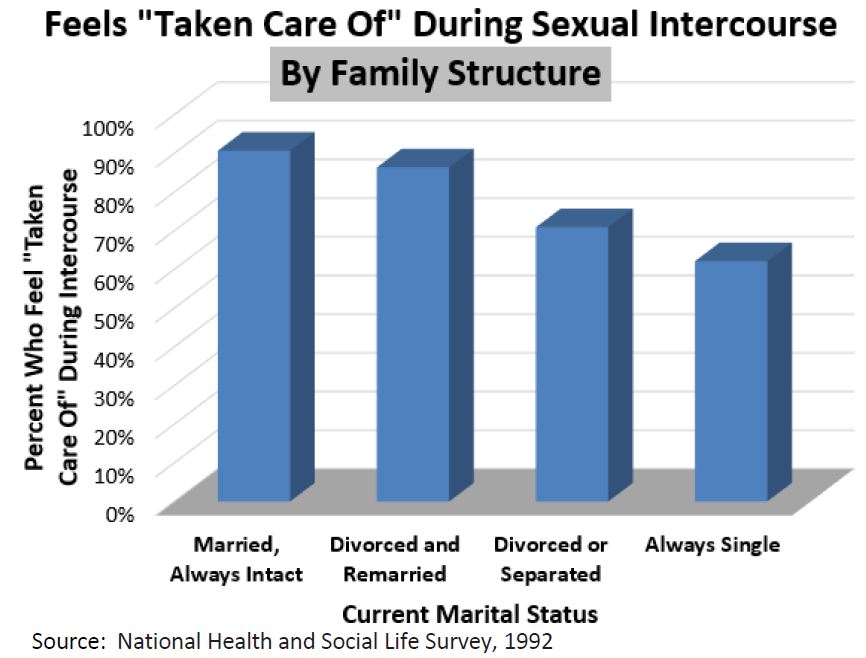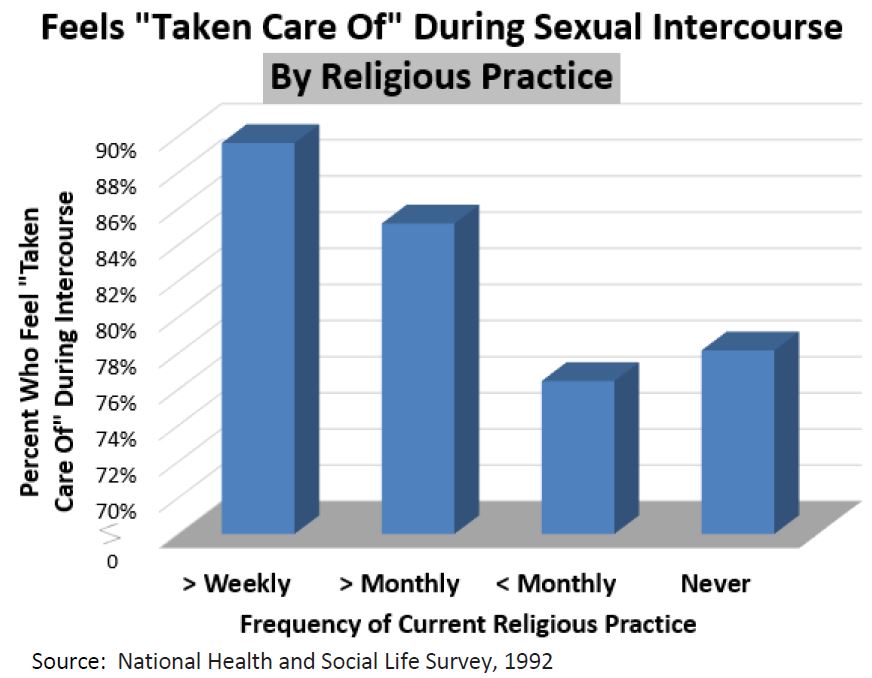Click Here to download “Feels “Taken Care Of” During Sexual Intercourse by Family Structure and Religious Practice”
Feels “Taken Care Of” During Sexual Intercourse by Family Structure and Religious Practice
The 1992 National Health and Social Life Survey shows that, of adults aged 18 to 59, those in intact marriages who worshipped weekly were most likely to report feeling “taken care of” during intercourse with their current sexual partner.
[1]
Family Structure: Those in always-intact marriages were most likely to report feeling “taken care of” during intercourse with their current sexual partner (90.7 percent), followed by those who were divorced and remarried (86.3 percent), those who were divorced or separated (70.9 percent), and those who were always single (62.1 percent).
 Religious Practice:
Religious Practice: Those who worshipped weekly at the time of the survey were most likely to report feeling “taken care of” during intercourse with their current sexual partner (89.6 percent), followed by those who worshipped less than weekly but at least monthly (85.2 percent), those who never worshipped (78.2 percent), and those who worshipped less than monthly (76.5 percent).
 Family Structure and Religious Practice Combined:
Family Structure and Religious Practice Combined: Those in intact marriages who worshipped weekly (94.4 percent) were most likely to report feeling “taken care of” during intercourse with their current sexual partner. Those in intact marriages who never worshipped (83.3 percent) and those in non-intact family structures who worshipped weekly (81.5 percent) were less likely to feel “taken care of”; those in non-intact family structures who never worshipped were least likely to feel “taken care of” (75.1 percent).
 Related Insights from Other Studies:
Related Insights from Other Studies: The period after childbirth is a relatively uncomfortable and vulnerable period for many women; between one quarter and one half feel less physically attractive postpartum.
[2] Marital quality is associated with tenderness between spouses and with intercourse during this postpartum period as well as during the pregnancy itself.
[3]
[1] These charts draw on data collected by the 1992 National Health and Social Life Survey
[2] L.C. Holtzman, “Sexual Practices during Pregnancy,”
The Journal of Midwifery and Women’s Health 21 (1976): 29-38; R.P. Perkins, “Sexuality in Pregnancy: What Determines Behaviour?”
Obstetrics and Gynecology 9 (1982): 189-198; C.P. Cowan and P.A. Cowan,
When Partners become Parents (New York, Basic: 1992), all as cited in Kirsten von Sydow, “Sexuality during Pregnancy and after Childbirth: A Metacontent Analysis of 59 Studies,”
Journal of Psychosomatic Research 47, no. 1 (1999): 38.
[3] S.A. Elliott and J.P. Watson, “Sex during Pregnancy and the First Postnatal Year,”
Journal of Psychosomatic Research 29 (1985): 541-548; Wendy Ellen Miller and Steven Friedman, “Male and Female Sexuality During Pregnancy: Behavior and Attitudes,”
Journal of Psychology and Human Sexuality 1, no. 2 (1988): 17-37; B. Reichle,
Die Geburt des ersten Kindes—eine Herausforderung für die Partnerschaft (Bielefeld: Kleine, 1994); G. Gloger-Tippelt and M. Huerkamp, “Parental relationship and security of infant-mother attachment,” manuscript submitted for publication, all as cited in Kirsten von Sydow, “Sexuality during Pregnancy and after Childbirth: A Metacontent Analysis of 59 Studies,”
Journal of Psychosomatic Research 47, no. 1 (1999): 41.]]>
 Religious Practice: Those who worshipped weekly at the time of the survey were most likely to report feeling “taken care of” during intercourse with their current sexual partner (89.6 percent), followed by those who worshipped less than weekly but at least monthly (85.2 percent), those who never worshipped (78.2 percent), and those who worshipped less than monthly (76.5 percent).
Religious Practice: Those who worshipped weekly at the time of the survey were most likely to report feeling “taken care of” during intercourse with their current sexual partner (89.6 percent), followed by those who worshipped less than weekly but at least monthly (85.2 percent), those who never worshipped (78.2 percent), and those who worshipped less than monthly (76.5 percent).
 Family Structure and Religious Practice Combined: Those in intact marriages who worshipped weekly (94.4 percent) were most likely to report feeling “taken care of” during intercourse with their current sexual partner. Those in intact marriages who never worshipped (83.3 percent) and those in non-intact family structures who worshipped weekly (81.5 percent) were less likely to feel “taken care of”; those in non-intact family structures who never worshipped were least likely to feel “taken care of” (75.1 percent).
Family Structure and Religious Practice Combined: Those in intact marriages who worshipped weekly (94.4 percent) were most likely to report feeling “taken care of” during intercourse with their current sexual partner. Those in intact marriages who never worshipped (83.3 percent) and those in non-intact family structures who worshipped weekly (81.5 percent) were less likely to feel “taken care of”; those in non-intact family structures who never worshipped were least likely to feel “taken care of” (75.1 percent).
 Related Insights from Other Studies: The period after childbirth is a relatively uncomfortable and vulnerable period for many women; between one quarter and one half feel less physically attractive postpartum.[2] Marital quality is associated with tenderness between spouses and with intercourse during this postpartum period as well as during the pregnancy itself.[3]
[1] These charts draw on data collected by the 1992 National Health and Social Life Survey
[2] L.C. Holtzman, “Sexual Practices during Pregnancy,” The Journal of Midwifery and Women’s Health 21 (1976): 29-38; R.P. Perkins, “Sexuality in Pregnancy: What Determines Behaviour?” Obstetrics and Gynecology 9 (1982): 189-198; C.P. Cowan and P.A. Cowan, When Partners become Parents (New York, Basic: 1992), all as cited in Kirsten von Sydow, “Sexuality during Pregnancy and after Childbirth: A Metacontent Analysis of 59 Studies,” Journal of Psychosomatic Research 47, no. 1 (1999): 38.
[3] S.A. Elliott and J.P. Watson, “Sex during Pregnancy and the First Postnatal Year,” Journal of Psychosomatic Research 29 (1985): 541-548; Wendy Ellen Miller and Steven Friedman, “Male and Female Sexuality During Pregnancy: Behavior and Attitudes,” Journal of Psychology and Human Sexuality 1, no. 2 (1988): 17-37; B. Reichle, Die Geburt des ersten Kindes—eine Herausforderung für die Partnerschaft (Bielefeld: Kleine, 1994); G. Gloger-Tippelt and M. Huerkamp, “Parental relationship and security of infant-mother attachment,” manuscript submitted for publication, all as cited in Kirsten von Sydow, “Sexuality during Pregnancy and after Childbirth: A Metacontent Analysis of 59 Studies,” Journal of Psychosomatic Research 47, no. 1 (1999): 41.]]>
Related Insights from Other Studies: The period after childbirth is a relatively uncomfortable and vulnerable period for many women; between one quarter and one half feel less physically attractive postpartum.[2] Marital quality is associated with tenderness between spouses and with intercourse during this postpartum period as well as during the pregnancy itself.[3]
[1] These charts draw on data collected by the 1992 National Health and Social Life Survey
[2] L.C. Holtzman, “Sexual Practices during Pregnancy,” The Journal of Midwifery and Women’s Health 21 (1976): 29-38; R.P. Perkins, “Sexuality in Pregnancy: What Determines Behaviour?” Obstetrics and Gynecology 9 (1982): 189-198; C.P. Cowan and P.A. Cowan, When Partners become Parents (New York, Basic: 1992), all as cited in Kirsten von Sydow, “Sexuality during Pregnancy and after Childbirth: A Metacontent Analysis of 59 Studies,” Journal of Psychosomatic Research 47, no. 1 (1999): 38.
[3] S.A. Elliott and J.P. Watson, “Sex during Pregnancy and the First Postnatal Year,” Journal of Psychosomatic Research 29 (1985): 541-548; Wendy Ellen Miller and Steven Friedman, “Male and Female Sexuality During Pregnancy: Behavior and Attitudes,” Journal of Psychology and Human Sexuality 1, no. 2 (1988): 17-37; B. Reichle, Die Geburt des ersten Kindes—eine Herausforderung für die Partnerschaft (Bielefeld: Kleine, 1994); G. Gloger-Tippelt and M. Huerkamp, “Parental relationship and security of infant-mother attachment,” manuscript submitted for publication, all as cited in Kirsten von Sydow, “Sexuality during Pregnancy and after Childbirth: A Metacontent Analysis of 59 Studies,” Journal of Psychosomatic Research 47, no. 1 (1999): 41.]]>
